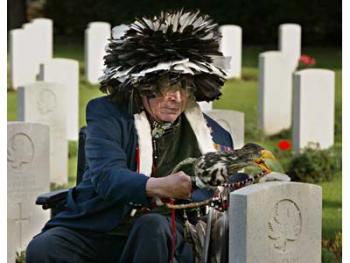Image Caption
Summary
By Pamela Sexsmith
Windspeaker.com Archives
For most of us, what we know about D-Day we learned from reading books or watching movies. For George Horse, that knowledge was earned first hand, on the beaches of Normandy.
Horse was a member of the Elite Sapper Battalion, a Canadian regiment of combat engineers who helped to smash the grip of Nazi Germany in the Second World War. He survived the horrors of the D-Day landing on June 6, 1944, but his military career ended that October when he was severely wounded on the front in Holland.
Born in 1919, George Horse grew up on Thunderchild First Nation. He enlisted in 1942, taking specialized training as a combat engineer at the Military School of Engineering in British Columbia.
"I was a sapper, which means 'to dig in', and boy, we had to do lots of digging to rout those Germans during the war. We knew it was dangerous work, handling explosives, planting, blowing and defusing bombs," Horse said. "We learned to shoot Tommy guns used in close quarter fighting and were taught unarmed combat with bare hands if you had to kill the enemy. It was good training and I used it more than once."
Shipped to Scotland in 1943, Horse was plunged into combat training in the cold salt spray of the North Sea.
"I belonged to the 3rd Canadian Infantry Division, attached to the 9th Brigade Canadian Army Infantry, the elite of the Canadian army chosen to crash into Hitler's west wall. The sapper battalion trained together for a year, in what was officially called 'combine operations,' as close to real combat conditions as possible," he said.
"Our training was part of the buildup of Operation Overlord, with Churchill as our war boss. The North Sea was very cold, but we were young and could take a lot of punishment. We had trained hard with an eight-mile run before breakfast every day, and soon became hard as nails.
"They told us it was preparation for D-Day. They never told us when or where it would happen, just somewhere in the English Channel, somewhere in France," he said.
"The Germans thought we were going to cross at Dover to Calais but we landed at a tiny French village called Rene Sur la Mare, where they least expected us. We travelled in open boats and carried collapsible bicycles in our back sacks, taking less than 20 minutes to ride to our first site. We missed being hit by the black spiders, steel girders and mines hid under the water to trip flat bottom landing craft during high tide. It is strange to think we made the actual D-Day landing. It seemed just like another training period although I knew the real stuff was coming at us."
That landing saw 152,000 Allied soldiers and 23,000 paratroopers storm the beaches of Normandy. The Canadians landed on Juno Beach, the Americans to their right on Cherbourg Peninsula (Omaha and Utah beach) the British to their left (Sword and Gold Beach.) By the end of the day, the Allies had secured all five beaches.
"We faced hand-to-hand combat. Stealth and silence was the main thing," Horse said. "We had to employ tactics like cutting a throat or breaking a neck to save our own hides. It was scary, seeing my fellow soldiers falling down, but we went through, and achieved our objective, a bridge that had to be dismantled. It was loaded with explosives, ready to be blown up by the Germans, and we needed that bridge for our armored units to cross. We were lucky. The free French of the interior had already been there and dismantled the explosives around the bridge; a wonderful bunch of boys."
Horse and his battalion pushed on, and after three grueling months of setting and defusing bombs in France and Belgium, dodging snipers and airborne bombardment, Horse's battalion reached the flooded marshlands of Holland where the main dykes had been blown during German occupation.
"We had to destroy road obstacles in the Dutch town of Breskens where the Germans had holed up. After our charge blew, we took shelter in a bunker, as bombardment came in from the North Sea. Something landed and exploded in the bunker. We never knew what. The blast was so powerful that it knocked us out for several hours. Lance Corporal Neil discovered me many hours later. He twiddled one of my feet and said 'Chief, are you all right?' I moved my feet. They were still there. My ears were humming. I couldn't walk straight," he said.
Horse was diagnosed with a severe concussion, and spent three months in an army hospital.
"I was never able to go back to the front, but felt I had served my purpose alongside friends in the military," he said.
Horse received a number of citations and service medals in recognition of his contributions to the war effort, including the 1939 to 1945 Star, France and Germany Star, Defence Medal and the Canadian Volunteer Service Medal.
In 2002, all surviving Canadian veterans who made the D-Day landing were invited to go to France and to fly directly over the beaches at Normandy. For Horse the trip brought back feelings of great joy and sadness.
"I enjoyed the trip but had a hard time when we visited the graves and cemeteries close to the beach, the final resting place of the boys that were killed there. It was a big sacrifice, but if old Hitler had won, things would have not been the same."
Horse passed away peacefully in his home on the Thunderchild First Nation Aug. 33, 2006 at the age of 87. His death came one year after the death of his great-grandson, US Marine Robert McCoy-Awasis in a bombing in Iraq.

